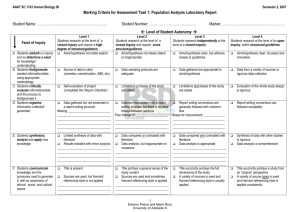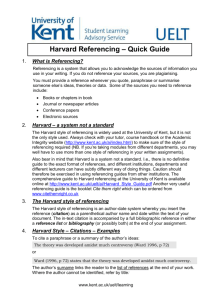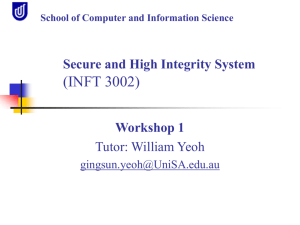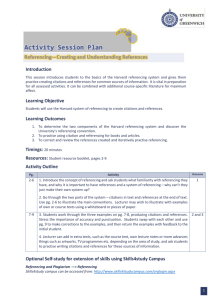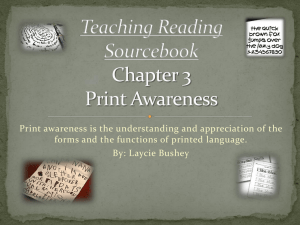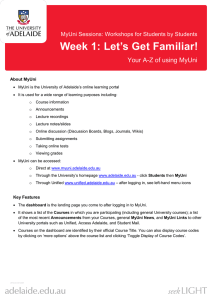HB Lit rsd task 3 explanation
advertisement
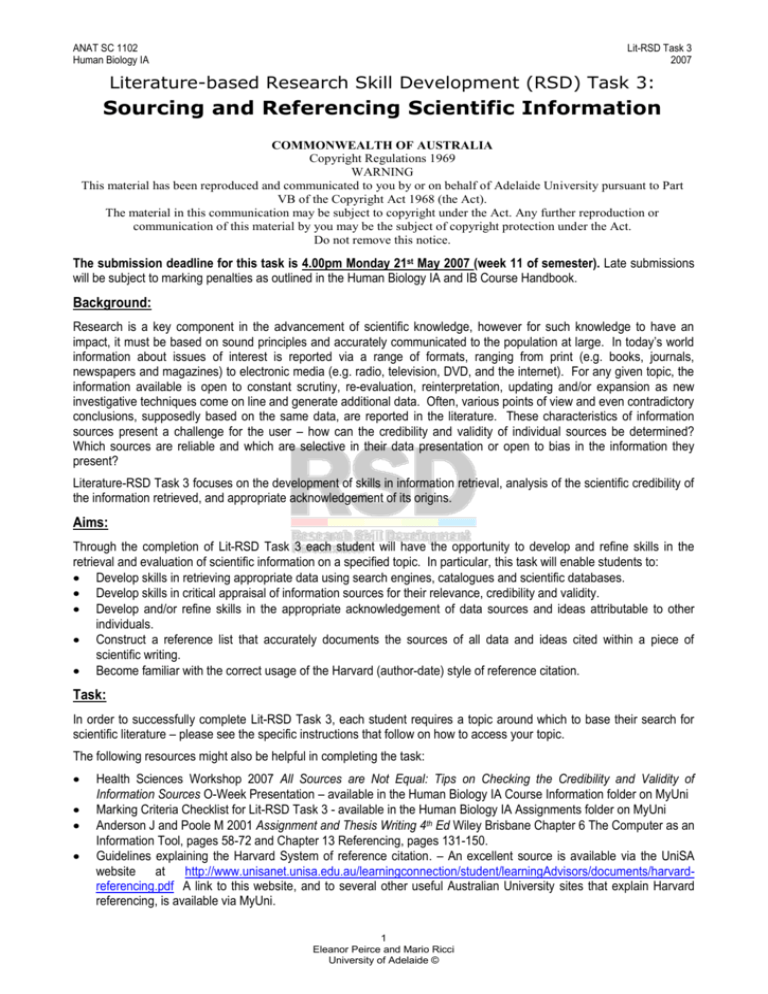
ANAT SC 1102 Human Biology IA Lit-RSD Task 3 2007 Literature-based Research Skill Development (RSD) Task 3: Sourcing and Referencing Scientific Information COMMONWEALTH OF AUSTRALIA Copyright Regulations 1969 WARNING This material has been reproduced and communicated to you by or on behalf of Adelaide University pursuant to Part VB of the Copyright Act 1968 (the Act). The material in this communication may be subject to copyright under the Act. Any further reproduction or communication of this material by you may be the subject of copyright protection under the Act. Do not remove this notice. The submission deadline for this task is 4.00pm Monday 21st May 2007 (week 11 of semester). Late submissions will be subject to marking penalties as outlined in the Human Biology IA and IB Course Handbook. Background: Research is a key component in the advancement of scientific knowledge, however for such knowledge to have an impact, it must be based on sound principles and accurately communicated to the population at large. In today’s world information about issues of interest is reported via a range of formats, ranging from print (e.g. books, journals, newspapers and magazines) to electronic media (e.g. radio, television, DVD, and the internet). For any given topic, the information available is open to constant scrutiny, re-evaluation, reinterpretation, updating and/or expansion as new investigative techniques come on line and generate additional data. Often, various points of view and even contradictory conclusions, supposedly based on the same data, are reported in the literature. These characteristics of information sources present a challenge for the user – how can the credibility and validity of individual sources be determined? Which sources are reliable and which are selective in their data presentation or open to bias in the information they present? Literature-RSD Task 3 focuses on the development of skills in information retrieval, analysis of the scientific credibility of the information retrieved, and appropriate acknowledgement of its origins. Aims: Through the completion of Lit-RSD Task 3 each student will have the opportunity to develop and refine skills in the retrieval and evaluation of scientific information on a specified topic. In particular, this task will enable students to: Develop skills in retrieving appropriate data using search engines, catalogues and scientific databases. Develop skills in critical appraisal of information sources for their relevance, credibility and validity. Develop and/or refine skills in the appropriate acknowledgement of data sources and ideas attributable to other individuals. Construct a reference list that accurately documents the sources of all data and ideas cited within a piece of scientific writing. Become familiar with the correct usage of the Harvard (author-date) style of reference citation. Task: In order to successfully complete Lit-RSD Task 3, each student requires a topic around which to base their search for scientific literature – please see the specific instructions that follow on how to access your topic. The following resources might also be helpful in completing the task: Health Sciences Workshop 2007 All Sources are Not Equal: Tips on Checking the Credibility and Validity of Information Sources O-Week Presentation – available in the Human Biology IA Course Information folder on MyUni Marking Criteria Checklist for Lit-RSD Task 3 - available in the Human Biology IA Assignments folder on MyUni Anderson J and Poole M 2001 Assignment and Thesis Writing 4th Ed Wiley Brisbane Chapter 6 The Computer as an Information Tool, pages 58-72 and Chapter 13 Referencing, pages 131-150. Guidelines explaining the Harvard System of reference citation. – An excellent source is available via the UniSA website at http://www.unisanet.unisa.edu.au/learningconnection/student/learningAdvisors/documents/harvardreferencing.pdf A link to this website, and to several other useful Australian University sites that explain Harvard referencing, is available via MyUni. 1 Eleanor Peirce and Mario Ricci University of Adelaide © Lit-RSD Task 3: Sourcing and Referencing Scientific Information Summary of Task: Each student will be assigned a topic related to the study of human biology. Students will search for information on the assigned topic using a variety of methods including indexing systems, catalogues, search engines and databases. All search strategies will be documented and an analysis of the scientific credibility and/or validity of the sources made. At least five sources of designated types will be selected and the information within them used to prepare a short review or summary (no more than 2-3 A4-sized pages, single spaced) addressing a specific aspect of the initial assigned topic. All information sources will be appropriately acknowledged within the text of the report, and full bibliographic details recorded in an appended reference list. The Harvard (author-date) referencing style will be used. The criteria that will be used in the assessment of this task are available in the Assignments folder on MyUni. Specific Instructions: Follow the steps indicated to ensure that each aspect of the RSD task is completed. STEP ONE Obtain a Topic for your Research 1. The topics to be used as a starting point for Lit-RSD Task 3 will be allocated by the course coordinators. To obtain a topic, email Dr Mario Ricci (mario.ricci@adelaide.edu.au), who will send you a number (between 1 and 15) by return email. 2. Once you have received your number, consult the list of topics for Lit-Rsd Task 3 that are posted in the Assignments Folder on MyUni and select the topic that corresponds to your number. 3. Please note: a record is kept of the number supplied to each individual student. Penalties will apply to students who select a topic different from the one allocated. If you are having problems researching your allocated topic, please contact the course coordinators for assistance. STEP TWO Search for Information on Your Topic. Use appropriate strategies to locate information about your allocated topic. After familiarising yourself with the general topic, select a specific aspect of the topic that you wish to research further and concentrate your searching in this area. Critically evaluate the information sources that you find and clearly document the methods/criteria applied in your evaluation; submit these as part of your search strategy (see Step Three). Select for use only sources that comply with the following specific guidelines. 1. Information must be derived from credible scientific sources (e.g. sources where it is apparent that content has been subjected to a peer review process). 2. The sources accessed should reflect the attributes expected of a university standard piece of writing. The bulk of information presented in the report must not be sourced from the following source types: Encyclopaedias, dictionaries or secondary school textbooks. These sources usually provide only generalized accounts in which details have been simplified to the point of inaccuracy. Lecture notes. Personal communications. Promotional brochures or advertising materials. These sources may be biased in that they may present an unbalanced viewpoint of the topic covered. NB. Commercial websites are also often biased or selective in the information or point of view that they present and should be avoided. 3. Do not use data obtained from web sites and other electronic sources from which the accuracy or authenticity of data cannot easily be verified. Such sites generally do not give an author or include details or evidence of the primary sources of their data. 4. The information sources used in the preparation of the review/summary must include the following: 2 Lit-RSD Task 3: Sourcing and Referencing Scientific Information At least two (2) primary research articles published in peer reviewed scientific journals. Primary research articles are actual accounts of the research by the people who have performed the scientific investigations. (Many research articles are available online through journal websites or via links from databases. Note that access to some of these sources may be by subscription only, or there may be a charge to access the article.) Two (2) appropriate online or web-based sources. These can include articles or reviews from online journals, other peer reviewed online publications, or government reports. A specialist textbook or monograph. Published conference proceedings, review articles, and the recommended textbooks may also be used if they contain relevant information however, do not rely on these as your major source. 5. Locate and read the full text of all articles or sources that you intend using to write the review/summary. Locating and reading only the abstract of a journal article in a database such as PubMed or Medline is not sufficient or acceptable. 6. Attach to your Lit-RSD Task a photocopy of the first page of each journal article, web page or chapter in a book from which you sourced information for your review/summary. The photocopy must include the relevant bibliographical details of the source. (Do not just include a copy of the book or journal cover or front page – proof of having accessed the actual article/information is required). STEP THREE Document the Strategies used in Finding Suitable Information about Your Topic. Provide a written account of how you located information sources on your topic, i.e. a search strategy. Details that must be supplied in the search strategy include: 1. The names of any indexes, catalogues, databases or search engines used to access information. [It is strongly recommended that scientific databases be used in preference to general Internet search engines.] A wide range of suitable databases can be easily accessed through the Barr Smith Library website. 2. The key words used in searching the catalogue, database or search engine, and how you determined these key words. 3. The number of responses obtained using particular keywords. 4. The nature of any search refinements employed to narrow the scope of the search and the rationale for these refinements. 5. The rationale used in the final selection of the article or the information site, i.e. the methods/criteria applied in evaluating the source. 6. Any other method employed in locating relevant data. Many of the details required can be documented by including with the assignment a printed version of the search pages in the various databases. Information about how to search for relevant information is provided in the Library Skills and PubMed tutorials on the Barr Smith Library website, and from the Barr Smith Library. STEP FOUR Use Relevant Information Obtained from Your Searches to Write a Short Review or Summary on a Specific Aspect of Your Topic. Once you have located appropriate information, use it to prepare a short review or summary of your topic (no longer than 2-3 pages) that is referenced using the Harvard referencing style. 1. The summary/review must be clearly structured, with an introduction, middle and end – consult the previous Lit-RSD Tasks (1 and 2) for information on how to structure your piece of writing. 2. The information presented within the summary/review must be relevant to its title, i.e. the title must reflect the specific content. 3 Lit-RSD Task 3: Sourcing and Referencing Scientific Information 3. All data and ideas sourced from the literature must be adequately acknowledged, both in the text of the report and in an attached reference list. Referencing must follow the Harvard (author-date) reference style. Check the suggested resources listed on page 1 for information about how to do this if you don’t know. There are numerous variations of the Harvard style that differ in their formatting of the elements within a citation, e.g. punctuation, font styles, use of brackets etc. (for examples, consult the various guidelines on Harvard referencing mentioned on page 1of this document). We strongly recommend that you select a particular version of the Harvard system and consistently apply the formatting style used within it, i.e. all elements within a citation should appear in the same order for all references within your references list, and the same punctuation and formatting should be used in each case. 4. Check your final version for grammatical correctness and completeness before submitting all components of Lit-RSD Task 3 for assessment. Attach a completed assignment coversheet to the front of your task and lodge it before the submission deadline in the assignment box in the corridor outside of the School of Medical Sciences Office level 3, Medical School North. 5. Please note: ASSESSMENT TASKS NOT LODGED AT THE CORRECT LOCATION WILL NOT BE MARKED AND A FAIL GRADE WILL BE RECORDED FOR THE TASK. The declaration on the coversheet must be signed. Please retain a photocopy of your written summary/review and search strategy as proof of having completed the work. 4

